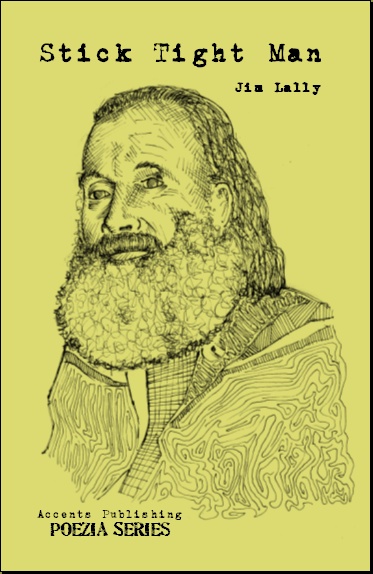Shae Davidson

A quote from Stanley Kunitz tucked away in Stick Tight Man expresses the roots of Jim Lally’s approach to writing: “gratitude for the gift of life.” Lally’s depiction of rural life in the twenty-first century celebrates lived experience by embracing the cycles of change and growth—and the attendant patterns of gain and loss.
Stick Tight Man, an entry in the Poezia Series from Accents Publishing, moves from half-forgotten tobacco sheds crumbling in the night to the lights flashing on a cell phone tower rising above a Kentucky hill, inviting readers to examine the tensions of change as they experience Lally’s subtle, reflective, vision. The poems move between the land and the modern world with a poignant awareness that connection to either involves sacrifice and loss, and that evolution can have unforeseen consequences.
Human physicality and our perception of the landscape overlap in the poems, creating a nuanced depiction of the visceral side of life. In the title piece, the speaker’s connection to the woods and fields around his home literally transforms his body—his original form and appearance lost under the “stick tights” (or burrs) picked up in his wanderings. Terrain and the body overlap in Lally’s works, offering a blended, sometimes ambiguous, connection to the physical world reminiscent of Walt Whitman, William Carlos Williams’ Paterson, or Ted Kooser’s musings on aging.
While Lally has a strong, vibrant sense of place, his work gives readers an intimate portrait of the Kentucky landscape that avoids provinciality or the danger of losing its themes in place-specific detail. The hills, flora, and architecture of the Bluegrass State provide media for Lally, but never mask his deeper interest in the pain and potential of change and the complex beauties of life. Rooted in the particular, the poems appeal to universal concerns.
Lally’s use of language mirrors the dynamic tension that frames the collection. The poems range from languid, structured, meditations that return to a single repeated line like an old worry stone to urgent snapshots that conceal chaos in carefully crafted stanzas. “Before the Snowstorm” races to the long moment before a blizzard begins, for instance, skillfully balancing the oppressive urgency of the looming storm with the enforced respite the blanket of snow will give the modern world.
Overall, Lally handles style and form much the same way he handles the particulars of place. The structure of the poems remains just below the surface, easily overshadowed by the skill with which the poems were crafted. The natural flow of the works—accented by the use of language described above—only highlights the organic subtly of the land and the complexity of change.
Jim Lally’s works are like Chinese landscape paintings: beautiful at first glance but growing in depth as new details emerge; incorporating form with seamless grace. Weaving together landscape and history, change and growth, they offer invaluable windows into rural life and the ways in which our environment and experiences shape one another. Collectively, they stand as tributes to both Lally’s skill and the landscape he loves.











No comments so far ↓
Nobody has commented yet. Be the first!
Comment